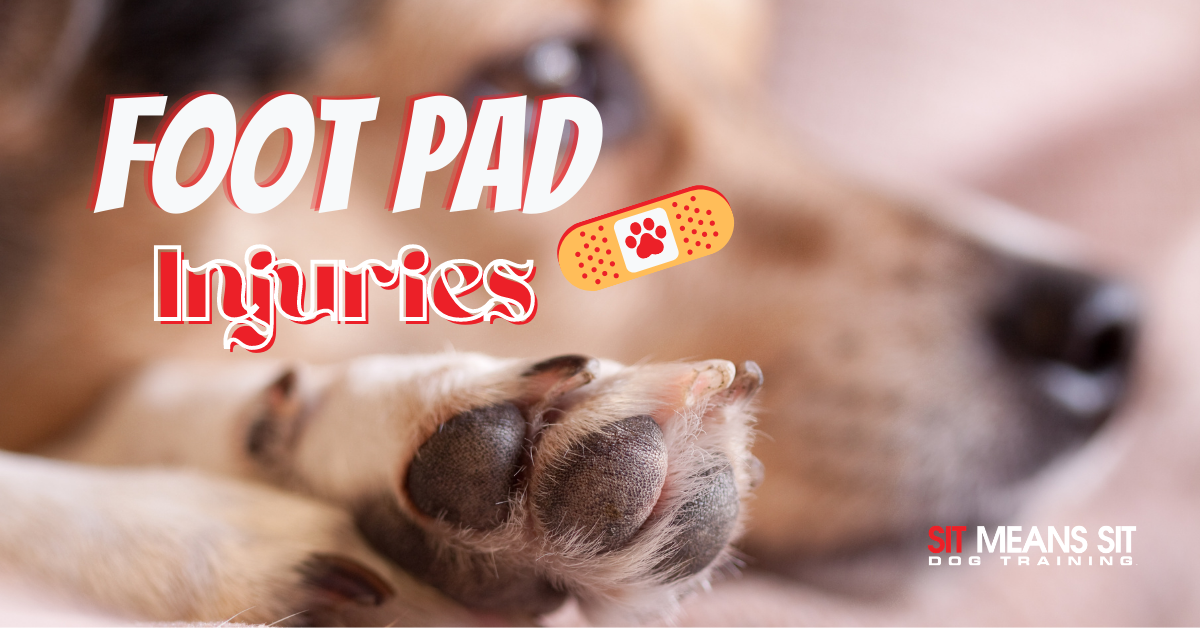
Understanding Foot Pad Injuries in Dogs
Dog’s paws are a critical part of their day to day, since they spend most of their waking moments relying on them. Besides being used for walking, running, and standing, your dog’s paws are a type of shock absorber protecting them against surfaces and indicating unnoticeable health concerns.
Your dog’s feet may be injured and you don’t even notice until they start acting odd. Their paw’s are essential to their everyday health, so it’s important to be aware of any injuries on their foot pads.
What are Foot Pads?
Foot pads are located at the bottom of your dog’s feet, usually rougher in texture and darker toned. They provide your pooch with traction, balance, regulate body temperature through sweating, and provide shock absorption when moving.
Each dog has three types of paw pads: the digital pad, the carpal pad, and the metatarsal pad.
Digital Pad– The 4 small pads located on the toes of the foot. They protect the joints and support the weight of your dog.
Carpal Pad– These are located on a dog’s forelimb and help support their weight.
Metatarsal Pad– They are located in the foot’s center and are often heart-shaped, supporting your dog’s body during motion.
Each pad type is contrived of connective tissue, thick skin, and fat. They are tougher, yet still soft, and act as your dog’s foot cushion.
Foot Pad Injuries
Foot pad injuries can come in a variety of forms for dogs including:
- Blisters
- Abrasions
- Ulcers
- Burns
- Tears
- Lacerations
- Punctures
These injuries are usually from the surface your dog walks on. Sharp objects like glass are able to puncture your dog’s foot pad, while hot surfaces like driveways in the summer can burn your dog’s paws. Their foot pads can also be impacted by rocks, gravel, sand, and chemicals, which is why dog-friendly products are so important!
Symptoms of Injuries
Not all foot pad injuries look or are felt the same by every dog. But some common signs of injuries include: limping, bleeding, and licking of the foot. Although some symptoms are more difficult to identify, look for these signs:
- Whining
- Limping
- Over-licking of the foot
- Bleeding of the foot
- Drowsiness
- Uninterested in usual activities
- Excess or heavy panting
These symptoms can turn very serious if not treated, so visit a vet immediately if you observe any signs of foot pad injury in your pup.
At-Home Care
Visiting a vet is best for most foot pad injuries, but you can treat any mild abrasions at home. First, rinse the injured foot under cooler water to remove dirt and debris. Second, apply over-the-counter ointment or solution to the wound, like Neosporin. Lastly, wrap the foot pad appropriately and keep the bandage clean and changed until the pad(s) has healed completely.
What to Avoid
Try to avoid hot or rough surfaces as it is not safe for your pup’s foot pads to go on. If you can’t or wouldn’t walk on it with your bare feet, then neither should your dog! Watch the area you are walking your dog or letting them play in for any loose or sharp objects that could injure them.
It’s also not ideal for your dog to be subject to cold surfaces as well, so don’t let them play in the snow for too long or it may injure their foot pads. Unless you have a breed that is adapted to cold temperatures, like a Husky, ice and snowy conditions are not made for their feet.
Dog boots are a form of protective gear to think about for your pup’s foot pads. They can be used in the winter or rainy season, while a balm or wax-substance is best for summer. Protective footwear is ideal for anytime you are unaware of the surfaces your dog may be walking on to prevent any injury.
Foot pad injuries can be extremely serious and should be taken that way. Visit the vet if you have any concerns about your pooch’s foot pads. Their skin doesn’t heal like regular skin, so it needs to be treated specially.
